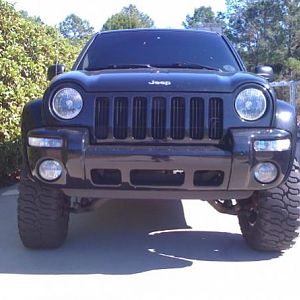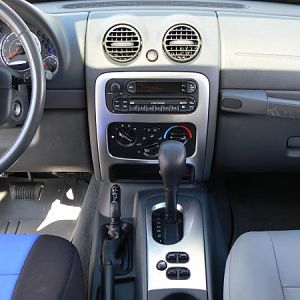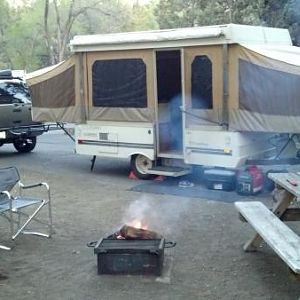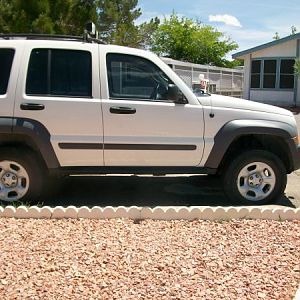HOW TO: Install Waterpump (3.7l engine)
Initial notes:
Some manuals suggest you remove the electric fan/shroud. I found no advantage to removing this (except it may have given me a couple of extra inches of working room) so I left it in. The choice is yours. The fan shroud is not difficult to remove, so if you feel more comfortable with extra room, do so.
First drain cooling system. I'll not provide total instructions for this because when I replaced my pump, I had suffered total failure of the water pump and almost all of the coolant from my engine was gone. Some people (including fine folks here on this site) strongly suggest not using the drain valve on the radiator. The reason stated is that some have claimed that once you open the drain valve, it never seals properly again. I have no opinion on this, but I lean towards the paranoid side, so I'll probably never use it. However, I didn't get all of my coolant drained which I comment on at the end of the procedure.
1. Remove lower radiator hose from water pump. The factory pipe clamp was a b*tch to get off. I strongly recommend a pair of channel locks to squeeze the factory pipe clamp fully open, then slide it down the hose well away from the aperture on the thermostat housing. Once the pressure on the aperture is off, use the channel locks to remove the hose. Coolant will drain out-- have a catchment system underneath your engine so you can properly catch draining coolant.
1b. If you have mechanical fan for heavy duty cooling, remove this. I don't have the mechanical (viscous) fan, but per comments in this thread, it appeared that what few instructions I relayed from my manual were incorrect. I'll reword (for copyright reasons) the Factory Service Manual (FSM) instructions:
2. Remove drive belt. Take a #15 socket and wrench, put it over tensioner bolt. Rotate wrench in a CLOCKWISE direction which releases tension on the belt. It might help to have a second set of hands to remove belt, but not absolutely necessary. Tip: A short breaker bar on wrench handle will make releasing the tension MUCH easier.
3. Remove Idler pulley. The service manual I had completely omitted this, but you must remove the idler pulley to get to the #8 bolt on the pump housing. Take the same #15 socket and wrench, and rotate wrench COUNTER-clockwise to loosen idler pulley mounting bolt. Again, breaker bar is STRONGLY recommended. My bolt wouldn't budge using all my strength on the wrench, and I became concerned I would bust knuckles if it suddenly broke free. I ended up using a 3' breaker bar, and even then it took a fair amount of pressure to loosen it.
4. Remove all eight pump housing bolts. This is fairly easy. It'll probably require a short socket extender- say 3". If you left the fan shroud on, you *might* struggle a little bit with getting your socket over the housing bolts, but it won't amount to much. Mysteriously, my manual said to remove pump pulley, yet provided no instructions on how to do that. It was made clear to me on this site that it was unnecessary in addition to requiring special tools. If you have a service manual you're also referring to and it suggests pump pulley removal, I strongly advise ignoring that instruction. It made no sense and was completely unnecessary. (it's possible the manual was in error and MEANT idler pulley (#3) and instead printed 'water pump pulley'- that might explain why they omitted that important step).
**IMPORTANT** Note pump housing bolts are two different lengths. I've got my pump back on and I don't recall, but I believe that bolt #1, #3 and #7 are longer than the others. As you can guess, these must go back into the same positions. However, if you get them mixed up, not to worry. You'll notice that the longer bolts go into holes where the threading starts a couple of inches down in the hole, whereas the short bolts go into holes which have immediate threading into the hole.
5. Remove pump. Fairly self explanatory. If it's not coming off the engine block, simply place a screwdriver between the pulley and the ouside of the pump housing and pull back. It should pop right off.
**IMPORTANT** Do not place screwdriver or any tool between pump housing and engine mating surface to pry pump off, this could score the mating surface and leave you with permanent leaks!
At this point some coolant will start coming out of the engine coolant cavity. I took a hose and sprayed it down to get rid of most of the coolant (as best I could). There shouldn't be much foreign material around the gasket area on the engine block, but there is some and it should be cleaned. Paint thinner or acetone is suggested for this. Also, a putty knife can be useful to *gently* scrape any sealant/gasket material film still clinging to the block. However, be very careful because you don't want to score the engine block and leave yourself with permanent leaks. Ie, don't use a chisel, screwdriver or any 'hard' tool. Most putty knives are soft and flexible and if you use a wide one, you shouldn't have any problem gently scraping off any remaining film that the Acetone didn't get without damaging the mating surface.
6. On new water pump, put a very thin film of RTV on the pump side of the gasket, then install gasket into pump. No RTV globs. The gasket should just feel a little tacky. Make sure it's well seated. The gasket is 'keyed' with a couple of tabs so that it can only be put in one way. Image shows my old pump with gasket- keys labeled for reference:
7. After gasket is installed in pump, put a very thin film of RTV on the outside (engine side) of the gasket. There should be no globs of RTV visible on the gasket at all. You don't want pieces of cured RTV breaking off down the road and floating around in your cooling system. Think of it as bits of plaque coming loose in a heart artery. All this does is provide a slighly tacky surface to help the gasket adhere to the engine block. The RTV is not really responsible for sealing the pump. The gasket is designed in such a way where it is pressed flat when the pump housing is torqued down, providing the seal.
8. Clean the pump housing bolt threads as best you can. Place a couple of bolts through housing before aligning pump back onto engine to help stabilize pump housing while getting it into position. I recommend the longer bolts (#1, #3, #7) as they will insert into their holes a couple of inches before seating on their threads.
9. Install remaining bolts onto pump housing and tighten in criss-cross pattern (shown below) to 40ft lbs of torque IN QUARTER TURN INCREMENTS. For those who don't know what this means or are inexperienced with this, you get all bolts tightened to where they're 'against' the pump housing, but the pump housing gasket hasn't been fully pressed down. Then with torque wrench, turn bolts (in sequence) 1/4 turn each-- you'll note that say, with 1st 1/4 turn, that torque may only go to 20 lbs. This is fine. After the 8th bolt has been through the first 1/4 turn, repeat the sequence and you'll note that torque may go to 35 lbs and so on until the last turn of the bolts results in 40lbs of torque. (Picture below labels bolts for tightening pattern with pump off for clarity):
10. Reattach lower radiator hose. I recommend changing to a new hose clamp for easier removal in the future. I used the screw type and made sure the screw head was facing straight up for easy future access.
11. Reattach idler pulley-- torque to 45 ft lbs.
12. Put drive belt back on using same technique in #2. Make sure belt is properly aligned on all points of contact. (see diagram in engine compartment)
13. Replace mechanical fan if present.
14. Using a 50/50 mixture of HOAT g-05 coolant (Zerex) and DISTILLED WATER, start refilling coolant reservoir.
**IMPORTANT** 3.7l engine capacity is 14 quarts or 3.5 gallons coolant. Depending on how effectively you drained your coolant will depend on how much you'll need to readd to the system. I strongly recommend doing this in small steps. Take a 1/2 gallon distilled water, 1/2 gallon antifreeze and mix into bucket, then pour into coolant reservoir. At some point it may fill up to cold-fill line. Turn engine over briefly (30 seconds or so) and this will circulate coolant and probably draw some of the coolant down into the engine and radiator, pulling air bubbles through system, giving you more room for more coolant mixture. Repeat as necessary until full-- however, you should only have to turn your engine over once, maybe twice. After that, when your reservoir shows full, it should be full.
When my water pump failed, I ended up only needing 2.5 gallons of coolant- meaning that my system still had around a gallon of coolant in the system. (basically, I didn't effectively drain all my coolant) Had I mixed 3.5 gallons of coolant, I'd have had a gallon left over that I would need to dispose of. Big waste.
Once everything is back in place, run engine and look for leaks. Continue to look for leaks over next few days just to be sure, including lower radiator hose over thermostat housing.
Initial notes:
Some manuals suggest you remove the electric fan/shroud. I found no advantage to removing this (except it may have given me a couple of extra inches of working room) so I left it in. The choice is yours. The fan shroud is not difficult to remove, so if you feel more comfortable with extra room, do so.
First drain cooling system. I'll not provide total instructions for this because when I replaced my pump, I had suffered total failure of the water pump and almost all of the coolant from my engine was gone. Some people (including fine folks here on this site) strongly suggest not using the drain valve on the radiator. The reason stated is that some have claimed that once you open the drain valve, it never seals properly again. I have no opinion on this, but I lean towards the paranoid side, so I'll probably never use it. However, I didn't get all of my coolant drained which I comment on at the end of the procedure.
1. Remove lower radiator hose from water pump. The factory pipe clamp was a b*tch to get off. I strongly recommend a pair of channel locks to squeeze the factory pipe clamp fully open, then slide it down the hose well away from the aperture on the thermostat housing. Once the pressure on the aperture is off, use the channel locks to remove the hose. Coolant will drain out-- have a catchment system underneath your engine so you can properly catch draining coolant.
1b. If you have mechanical fan for heavy duty cooling, remove this. I don't have the mechanical (viscous) fan, but per comments in this thread, it appeared that what few instructions I relayed from my manual were incorrect. I'll reword (for copyright reasons) the Factory Service Manual (FSM) instructions:
Using spanner wrench "6598" and "8346" adapter, turn mounting nut COUNTERCLOCKWISE as viewed from front. Threads on viscous fan drive are RIGHT HAND. See TJKJ2002's post #7 (below) for tools and technique tips.
2. Remove drive belt. Take a #15 socket and wrench, put it over tensioner bolt. Rotate wrench in a CLOCKWISE direction which releases tension on the belt. It might help to have a second set of hands to remove belt, but not absolutely necessary. Tip: A short breaker bar on wrench handle will make releasing the tension MUCH easier.
3. Remove Idler pulley. The service manual I had completely omitted this, but you must remove the idler pulley to get to the #8 bolt on the pump housing. Take the same #15 socket and wrench, and rotate wrench COUNTER-clockwise to loosen idler pulley mounting bolt. Again, breaker bar is STRONGLY recommended. My bolt wouldn't budge using all my strength on the wrench, and I became concerned I would bust knuckles if it suddenly broke free. I ended up using a 3' breaker bar, and even then it took a fair amount of pressure to loosen it.
4. Remove all eight pump housing bolts. This is fairly easy. It'll probably require a short socket extender- say 3". If you left the fan shroud on, you *might* struggle a little bit with getting your socket over the housing bolts, but it won't amount to much. Mysteriously, my manual said to remove pump pulley, yet provided no instructions on how to do that. It was made clear to me on this site that it was unnecessary in addition to requiring special tools. If you have a service manual you're also referring to and it suggests pump pulley removal, I strongly advise ignoring that instruction. It made no sense and was completely unnecessary. (it's possible the manual was in error and MEANT idler pulley (#3) and instead printed 'water pump pulley'- that might explain why they omitted that important step).
**IMPORTANT** Note pump housing bolts are two different lengths. I've got my pump back on and I don't recall, but I believe that bolt #1, #3 and #7 are longer than the others. As you can guess, these must go back into the same positions. However, if you get them mixed up, not to worry. You'll notice that the longer bolts go into holes where the threading starts a couple of inches down in the hole, whereas the short bolts go into holes which have immediate threading into the hole.
5. Remove pump. Fairly self explanatory. If it's not coming off the engine block, simply place a screwdriver between the pulley and the ouside of the pump housing and pull back. It should pop right off.
**IMPORTANT** Do not place screwdriver or any tool between pump housing and engine mating surface to pry pump off, this could score the mating surface and leave you with permanent leaks!
At this point some coolant will start coming out of the engine coolant cavity. I took a hose and sprayed it down to get rid of most of the coolant (as best I could). There shouldn't be much foreign material around the gasket area on the engine block, but there is some and it should be cleaned. Paint thinner or acetone is suggested for this. Also, a putty knife can be useful to *gently* scrape any sealant/gasket material film still clinging to the block. However, be very careful because you don't want to score the engine block and leave yourself with permanent leaks. Ie, don't use a chisel, screwdriver or any 'hard' tool. Most putty knives are soft and flexible and if you use a wide one, you shouldn't have any problem gently scraping off any remaining film that the Acetone didn't get without damaging the mating surface.
6. On new water pump, put a very thin film of RTV on the pump side of the gasket, then install gasket into pump. No RTV globs. The gasket should just feel a little tacky. Make sure it's well seated. The gasket is 'keyed' with a couple of tabs so that it can only be put in one way. Image shows my old pump with gasket- keys labeled for reference:
You must be registered for see images attach
7. After gasket is installed in pump, put a very thin film of RTV on the outside (engine side) of the gasket. There should be no globs of RTV visible on the gasket at all. You don't want pieces of cured RTV breaking off down the road and floating around in your cooling system. Think of it as bits of plaque coming loose in a heart artery. All this does is provide a slighly tacky surface to help the gasket adhere to the engine block. The RTV is not really responsible for sealing the pump. The gasket is designed in such a way where it is pressed flat when the pump housing is torqued down, providing the seal.
8. Clean the pump housing bolt threads as best you can. Place a couple of bolts through housing before aligning pump back onto engine to help stabilize pump housing while getting it into position. I recommend the longer bolts (#1, #3, #7) as they will insert into their holes a couple of inches before seating on their threads.
9. Install remaining bolts onto pump housing and tighten in criss-cross pattern (shown below) to 40ft lbs of torque IN QUARTER TURN INCREMENTS. For those who don't know what this means or are inexperienced with this, you get all bolts tightened to where they're 'against' the pump housing, but the pump housing gasket hasn't been fully pressed down. Then with torque wrench, turn bolts (in sequence) 1/4 turn each-- you'll note that say, with 1st 1/4 turn, that torque may only go to 20 lbs. This is fine. After the 8th bolt has been through the first 1/4 turn, repeat the sequence and you'll note that torque may go to 35 lbs and so on until the last turn of the bolts results in 40lbs of torque. (Picture below labels bolts for tightening pattern with pump off for clarity):
You must be registered for see images attach
10. Reattach lower radiator hose. I recommend changing to a new hose clamp for easier removal in the future. I used the screw type and made sure the screw head was facing straight up for easy future access.
11. Reattach idler pulley-- torque to 45 ft lbs.
12. Put drive belt back on using same technique in #2. Make sure belt is properly aligned on all points of contact. (see diagram in engine compartment)
13. Replace mechanical fan if present.
14. Using a 50/50 mixture of HOAT g-05 coolant (Zerex) and DISTILLED WATER, start refilling coolant reservoir.
**IMPORTANT** 3.7l engine capacity is 14 quarts or 3.5 gallons coolant. Depending on how effectively you drained your coolant will depend on how much you'll need to readd to the system. I strongly recommend doing this in small steps. Take a 1/2 gallon distilled water, 1/2 gallon antifreeze and mix into bucket, then pour into coolant reservoir. At some point it may fill up to cold-fill line. Turn engine over briefly (30 seconds or so) and this will circulate coolant and probably draw some of the coolant down into the engine and radiator, pulling air bubbles through system, giving you more room for more coolant mixture. Repeat as necessary until full-- however, you should only have to turn your engine over once, maybe twice. After that, when your reservoir shows full, it should be full.
When my water pump failed, I ended up only needing 2.5 gallons of coolant- meaning that my system still had around a gallon of coolant in the system. (basically, I didn't effectively drain all my coolant) Had I mixed 3.5 gallons of coolant, I'd have had a gallon left over that I would need to dispose of. Big waste.
Once everything is back in place, run engine and look for leaks. Continue to look for leaks over next few days just to be sure, including lower radiator hose over thermostat housing.
Last edited:










